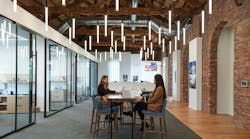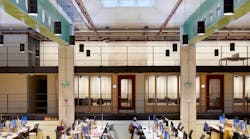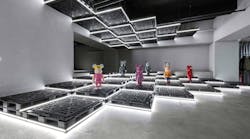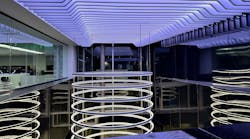Lighting a modern sports and recreation center presents challenges far different from those of a commercial building. Not only are budgets often tighter because such projects tend to be financed by public money, says Matthew Crummey, an associate principal at the Dallas office of global design firm Perkins&Will, but the sprawling facilities often have a complex program—from natatoriums to gymnasiums, offices, locker rooms, and cafés—with requirements for light intensity, glare levels, and sight lines that vary widely.
Then there’s the matter of fixture durability. “If you’re working in a corporate lobby,” Crummey notes, “you don’t expect people to be throwing around basketballs and Frisbees.”
In recreation facilities, user abuse is more or less a given. And while lighting plans for these buildings must tolerate such strains, they also must be approached with sensitivity to the civic functions of these projects. For a growing number of cities, colleges, and universities, says Robyn Goldstein, a principal at the Boston office of HLB Lighting Design, recreation facilities serve as signature spaces to recruit top athletes, advance community health and wellness goals, demonstrate energy conservation strategies, and host competitions and community events.
Click on the links below for two sports and recreation centers that use lighting and illumination to create stunning spaces that satisfied their owners' budgetary and performance expectations.
- Eastside Recreation Center, El Paso, Texas.
- Harold Alfond Athletics and Recreation Center, Colby College, Waterville, Maine.
This feature appeared in the Fall/Winter 2023 of Architectural SSL.






